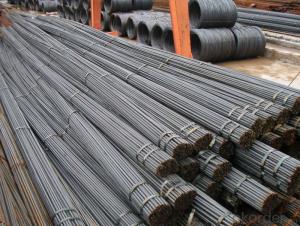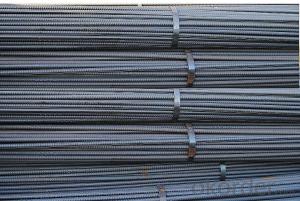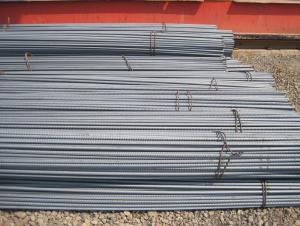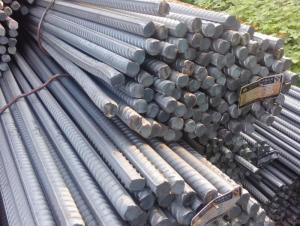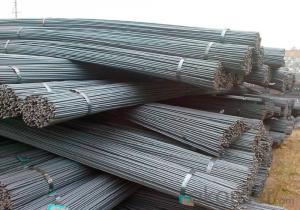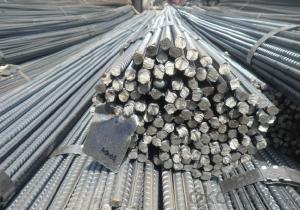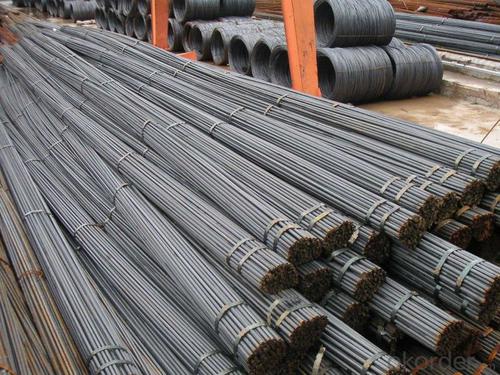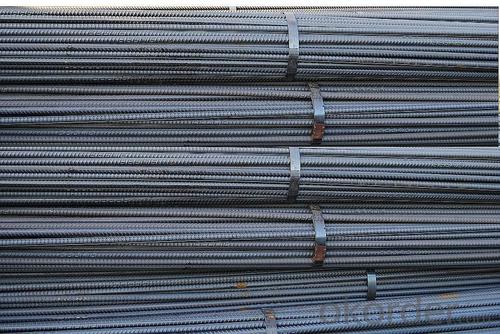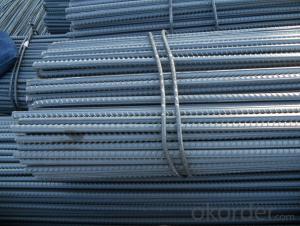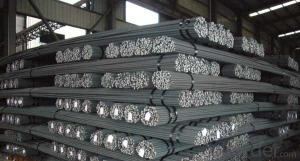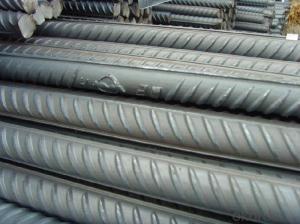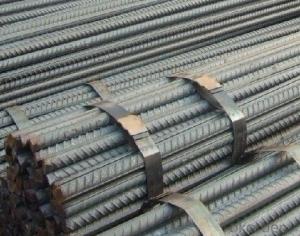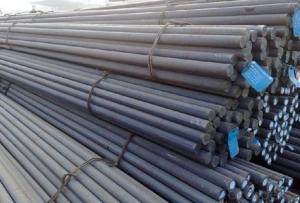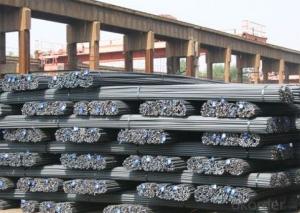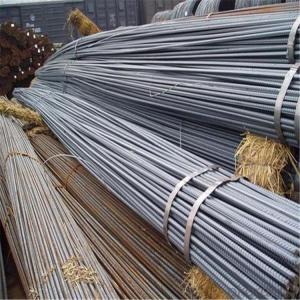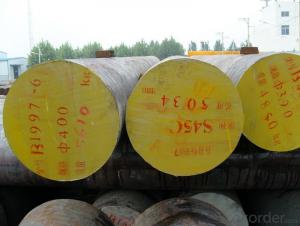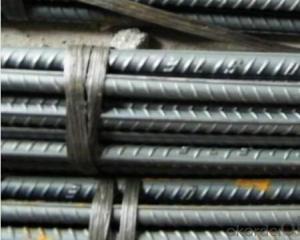HRB500 Deformed Steel Bar /Steel Rebars
- Loading Port:
- China main port
- Payment Terms:
- TT OR LC
- Min Order Qty:
- 100 m.t.
- Supply Capability:
- 100000 m.t./month
OKorder Service Pledge
OKorder Financial Service
You Might Also Like
Specification
HRB500 Deformed Steel Bar /Steel Rebars
Specifications
Standard: ASTM, GB, JIS, BS, AISI
Grade: HRB400, HRB335, HRB500, GR60
Length:6m, 9m,12m
Diameter: 8-40mm
Product Description
Type | steel rebar |
Standard Grade | a. GB1499.2-2007, HRB335, HRB400, etc. |
b. ASTM A615 Gr.40, Gr.60, etc. | |
c. BS4449, etc. d. JISG3112-SD390 | |
Diameter | 6mm-32mm etc. as per customers' requirement |
Length | 6m, 8m, 9m,12m as standard |
Application | Construction, shipping, building material |
Packing | standard export packing, or as per customers' requirement |
Quality | First quality |
Delivery time | Right now after the deposit. |
Others | 1. our products conform to all the standards |
2. we can offer special specification products as per our customers | |
3. we can offer the original mill test certificate and original product |
Physical Property-HRB500
Dia (mm) | Length(m) | Chemical composition (%) | Yield Strength(N/cm2) | Tensile Strength(N/cm2) | Elongation (%) | Benden 180° 3d | ||||
C | Mn | Si | S | P | MPa | |||||
Ø12 | 12 | 0.24 | 1.35 | 0.52 | 0.024 | 0.027 | 530 | 660 | 14 | OK |
Products
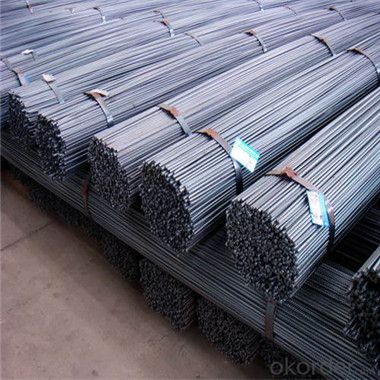
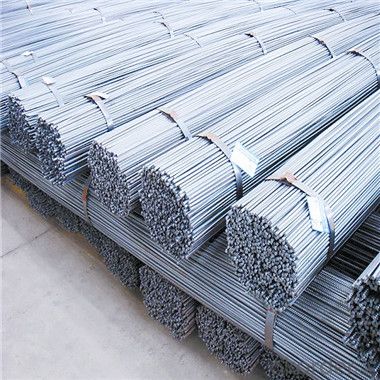
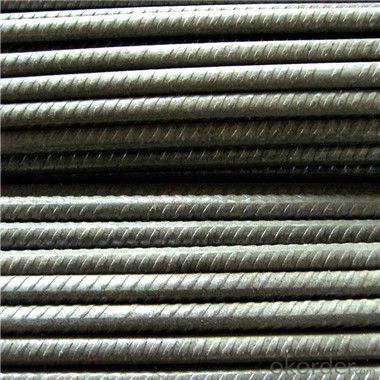
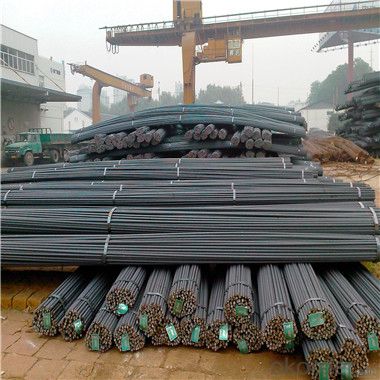
- Q: Can steel rebars be used in underground construction projects?
- Indeed, steel rebars have the ability to be utilized in underground construction endeavors. In fact, rebars are commonly employed in a wide array of construction projects, including those involving subterranean structures. The primary purpose of steel rebars is to fortify concrete and furnish the structure with added strength and stability. In underground construction specifically, rebars are frequently employed in the creation of foundations, walls, and columns to fortify the concrete and guarantee the integrity of the structure. By incorporating steel rebars into underground construction projects, the load-bearing capacity of the concrete is significantly enhanced, rendering it more impervious to the pressure and forces exerted by the surrounding soil and groundwater. Furthermore, steel rebars possess exceptional durability and corrosion resistance, thus rendering them appropriate for subterranean environments where they may be exposed to moisture and other potentially harmful elements. In sum, the inclusion of steel rebars in underground construction endeavors is absolutely vital in order to ensure the structural stability and longevity of these below-ground structures.
- Q: How do steel rebars contribute to the overall fire resistance of a structure?
- Steel rebars, also known as reinforcing bars, play a crucial role in enhancing the fire resistance of a structure. They contribute to the overall fire resistance in several ways. Firstly, steel rebars are typically made from a material known for its high melting point and excellent heat resistance. This means that even in the event of a fire, the rebars retain their structural integrity and do not deform or collapse easily. This is especially important in high-rise buildings where the temperature during a fire can reach extreme levels. Secondly, the presence of steel rebars helps to distribute heat evenly throughout the structure. When exposed to high temperatures, steel absorbs and conducts heat away from the fire source, preventing localized hotspots and minimizing the risk of structural failure. This redistribution of heat helps to maintain the stability and integrity of the building, providing occupants with valuable time to evacuate safely. Furthermore, steel rebars are often embedded within concrete, forming a composite material commonly referred to as reinforced concrete. The combination of steel and concrete creates a synergistic effect in terms of fire resistance. While steel has high tensile strength, concrete has excellent compressive strength. When exposed to fire, the concrete acts as a protective layer, slowing down the heat transfer to the steel rebars. This delay in heat transfer allows the steel to maintain its strength for a longer period, further enhancing the fire resistance of the structure. Additionally, steel rebars help to prevent the spread of fire by creating compartmentalization within the building. In the event of a fire, the reinforced concrete structure acts as a barrier, limiting the fire's ability to spread from one area to another. This containment of fire reduces the potential damage and allows emergency responders to control and extinguish the fire more effectively. In conclusion, steel rebars significantly contribute to the overall fire resistance of a structure. Their high melting point, heat redistribution capabilities, and combination with concrete create a reliable and durable fire-resistant system. By providing structural stability, preventing localized hotspots, and limiting the spread of fire, steel rebars play a critical role in ensuring the safety and protection of both the building and its occupants during a fire incident.
- Q: What are the advantages of using composite steel rebars?
- Using composite steel rebars in construction projects offers numerous benefits. Firstly, they provide superior strength and durability compared to traditional rebars. The combination of steel and a fiber-reinforced polymer (FRP) composite material enhances tensile strength, resulting in a more robust and resilient structure. This is especially advantageous in areas with high seismic activity or extreme weather conditions, where the reinforcement must withstand significant forces. Secondly, composite steel rebars exhibit high resistance to corrosion. Traditional steel rebars are susceptible to corrosion when exposed to moisture and chemicals, causing structural degradation over time. However, the addition of a protective FRP composite layer effectively shields the steel from these corrosive elements, extending the reinforcement's lifespan and reducing the need for frequent maintenance. Furthermore, composite steel rebars offer a lightweight alternative to conventional steel reinforcement. By utilizing FRP composites, the weight of the rebars is significantly reduced while maintaining their structural integrity. This characteristic makes transportation and installation easier, ultimately reducing construction time and costs. Moreover, composite steel rebars possess excellent electrical and thermal insulation properties. Unlike traditional steel rebars, which are conductive, the FRP composite layer acts as an insulator. This minimizes the risk of electrical hazards and prevents the transfer of heat. Such insulation is particularly advantageous in structures that require control over electrical or thermal conductivity, such as power plants or buildings with sensitive equipment. Lastly, composite steel rebars are environmentally friendly. The production of steel rebars typically consumes a significant amount of energy and emits greenhouse gases. However, by utilizing FRP composites, the overall carbon footprint of the reinforcement is reduced, making it a more sustainable choice. In conclusion, the use of composite steel rebars offers enhanced strength, corrosion resistance, lightweight construction, electrical and thermal insulation, and environmental sustainability. These advantages make composite steel rebars a compelling choice for various construction applications.
- Q: What are the recommended practices for welding steel rebars?
- The recommended practices for welding steel rebars include ensuring proper surface preparation to remove any contaminants, selecting the appropriate welding process (such as shielded metal arc welding or gas metal arc welding), using the correct electrode or filler material, maintaining the appropriate welding parameters (current, voltage, travel speed), and performing regular inspections to ensure the quality and integrity of the welds. It is also important to follow safety guidelines, such as wearing appropriate protective equipment and working in a well-ventilated area.
- Q: What are the sizes available for steel rebars?
- Steel rebars, also known as reinforcing bars, come in various sizes to suit different construction needs. The sizes available for steel rebars typically range from #3 to #18. Each size is denoted by a number, which corresponds to the diameter of the bar in inches. For example, a #3 rebar has a diameter of 3/8 inch, while a #18 rebar has a diameter of 2 1/4 inches. These sizes are standardized and commonly used in construction projects worldwide. The choice of rebar size depends on factors such as the structural requirements, load-bearing capacity, and specific engineering specifications for a particular project. The larger the diameter of the rebar, the higher its strength and load-bearing capacity. It is important to note that the availability of sizes may vary depending on the region or country, as different standards and regulations may be followed. It is always recommended to consult local building codes and engineering professionals to determine the appropriate size of steel rebars to be used in a construction project.
- Q: How do steel rebars affect the overall seismic performance of a structure?
- The overall seismic performance of a structure is greatly enhanced by steel rebars. Seismic events, like earthquakes, exert dynamic forces on buildings, causing them to vibrate and possibly collapse. However, incorporating steel rebars in concrete structures significantly enhances their ability to withstand these forces and ensures the safety of those inside. First and foremost, steel rebars strengthen a building's structure. By reinforcing the concrete, they increase its tensile strength since concrete alone is weak in tension. During an earthquake, the rebars help distribute the dynamic forces throughout the structure, preventing stress concentration in specific areas. This redistribution of forces minimizes the risk of localized failures and maintains the stability of the structure. Moreover, steel rebars improve the ductility of a structure. Ductility refers to a material's ability to deform under stress without breaking. During an earthquake, buildings undergo significant lateral movements and deformations. Steel rebars, with their high ductility, can elongate and stretch without fracturing, absorbing and dissipating the seismic energy. This property enables the structure to withstand larger ground motions and reduces the chance of sudden collapse. Furthermore, steel rebars enhance the overall resilience of a structure. Resilience refers to a building's ability to quickly recover its functionality after an earthquake. By reinforcing the concrete, steel rebars contribute to the post-earthquake repairability of the structure. They ensure that the building maintains its load-carrying capacity even after sustaining damage, which reduces downtime and allows for a faster recovery. Additionally, steel rebars serve as a warning sign for potential structural issues. During an earthquake, cracks may appear in the concrete, indicating areas of stress concentration. These cracks are often visible around the rebars, acting as an early indication of structural vulnerability. This visual warning allows for timely inspection and repair, preventing further damage and ensuring the long-term safety of the building. In conclusion, steel rebars play a crucial role in enhancing the overall seismic performance of a structure. Their inclusion in concrete greatly improves structural integrity, increases ductility, enhances resilience, and provides visual warnings of potential issues. By reinforcing the concrete, steel rebars ensure that buildings can withstand seismic forces, reducing the risk of collapse and ensuring the safety of occupants during earthquakes.
- Q: How many kinds of steel are needed to build the building?
- The construction steel used to construct buildings can usually be divided into steel structures, steel and reinforced concrete structures. Steel structural steel mainly consists of ordinary carbon structural steel and low alloy structural steel. It's made of steel, steel pipe and steel bar. There are angle steel, I-beam and channel steel in section steel. Reinforcing bars for reinforced concrete structures.
- Q: How do steel rebars contribute to the strength of a structure?
- Steel rebars contribute to the strength of a structure by providing reinforcement and enhancing its structural integrity. These high-strength steel bars are embedded within concrete to resist tensile forces that concrete alone cannot withstand. By distributing stress and preventing cracking or failure, rebars help ensure the overall stability and durability of the structure, especially in areas prone to seismic activity or heavy loads.
- Q: What are the different sizes of steel rebars available?
- The different sizes of steel rebars available vary depending on the specific needs and requirements of a construction project. Common sizes include #3 (3/8 inch), #4 (1/2 inch), #5 (5/8 inch), #6 (3/4 inch), #7 (7/8 inch), and #8 (1 inch). However, rebars can be manufactured in other sizes as well to cater to different structural applications.
- Q: Can steel rebars be bent without breaking?
- Yes, steel rebars can be bent without breaking, as they possess excellent flexibility and ductility. They are designed to withstand bending forces during construction processes, making them suitable for various applications in reinforced concrete structures.
Send your message to us
HRB500 Deformed Steel Bar /Steel Rebars
- Loading Port:
- China main port
- Payment Terms:
- TT OR LC
- Min Order Qty:
- 100 m.t.
- Supply Capability:
- 100000 m.t./month
OKorder Service Pledge
OKorder Financial Service
Similar products
Hot products
Hot Searches
Related keywords
